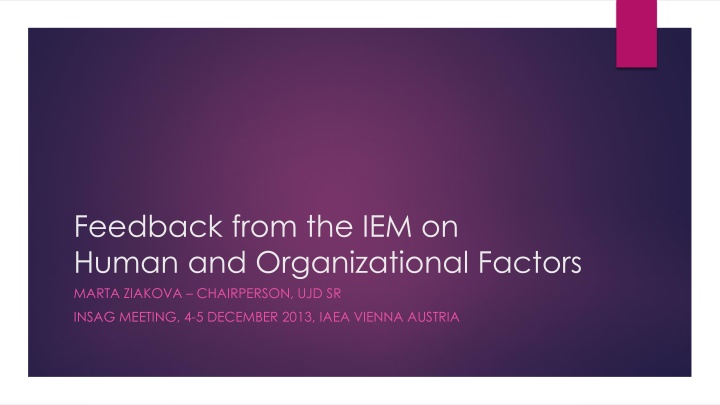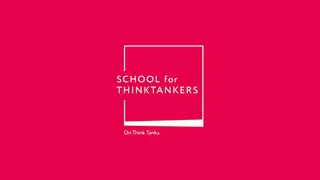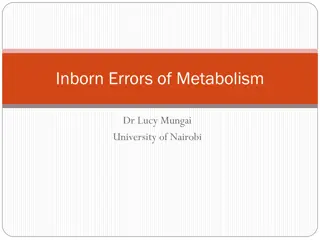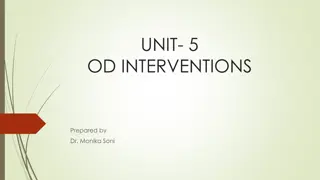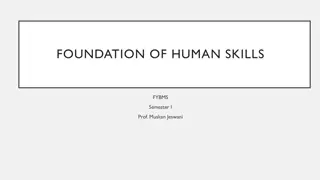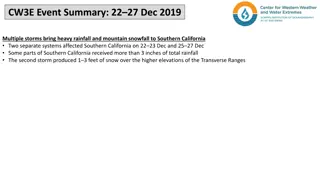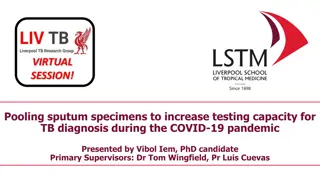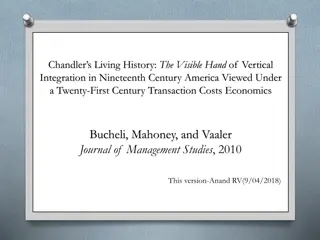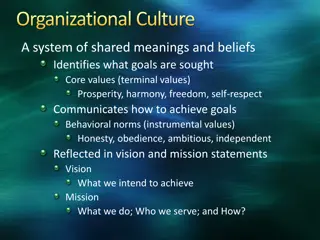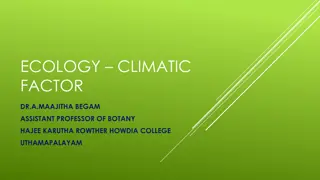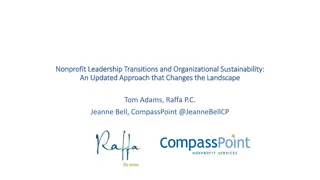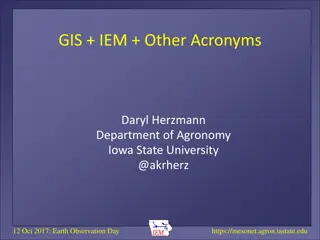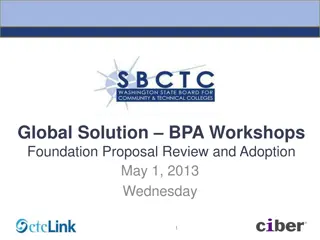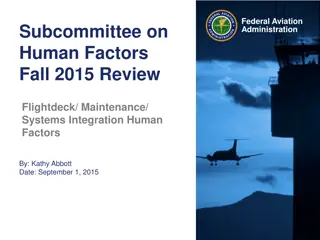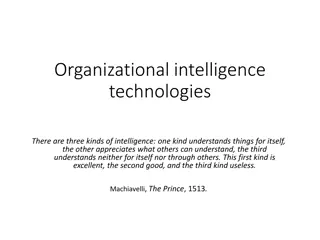Insights from IEM on Human and Organizational Factors - December 2013
The IEM on Human and Organizational Factors held in December 2013 in Vienna, Austria, aimed to analyze nuclear safety aspects, improve safety culture, and identify priority research areas. The meeting gathered experts who shared experiences, lessons, and future insights on HOF. Key objectives included strengthening safety in organizations, exchanging knowledge on safety culture, and evaluating defenses in nuclear facilities. The meeting featured presentations, discussions, and collaborations among participants from diverse organizations.
Download Presentation

Please find below an Image/Link to download the presentation.
The content on the website is provided AS IS for your information and personal use only. It may not be sold, licensed, or shared on other websites without obtaining consent from the author.If you encounter any issues during the download, it is possible that the publisher has removed the file from their server.
You are allowed to download the files provided on this website for personal or commercial use, subject to the condition that they are used lawfully. All files are the property of their respective owners.
The content on the website is provided AS IS for your information and personal use only. It may not be sold, licensed, or shared on other websites without obtaining consent from the author.
E N D
Presentation Transcript
Feedback from the IEM on Human and Organizational Factors MARTA ZIAKOVA CHAIRPERSON, UJD SR INSAG MEETING, 4-5 DECEMBER 2013, IAEA VIENNA AUSTRIA
2 International Experts Meeting INSAG meeting, 4-5 December 2013, IAEA Vienna Austria Dec 5, 2013
3 IAEA Action Plan unanimously endorsed by the Member States in September 2011 sets down 12 Actions and 39 sub actions with the aim of defining a programme of work to strengthen the global nuclear safety framework One of these actions deals with communication and information dissemination with the objective of enhancing transparency and effectiveness of communication and improve dissemination of information. This action specifically requests the IAEA Secretariat to organize international experts meetings (IEMs) to analyze all relevant technical aspects and learn the lessons from the Fukushima Daiichi nuclear accident. INSAG meeting, 4-5 December 2013, IAEA Vienna Austria Dec 5, 2013
4 The objectives of this IEM on HOF Identify the means to improve and strengthen human and organizational aspects of nuclear safety in operating and regulatory organizations; Analyse best practices from the responses to previous nuclear events that are being used to improve and strengthen safety culture; Exchange information on the interactions between individuals, technology and organizations and their influence on nuclear safety Evaluate the means currently being used to improve defense in depth at nuclear facilities from an organizational perspective; and, Identify potential priority areas for research and development. INSAG meeting, 4-5 December 2013, IAEA Vienna Austria Dec 5, 2013
5 General information on IEM 5 155 participants from 40 MS and 4 international organizations governmental, regulatory, operating, technical support, research and educational organizations 46 expert presentations from keynote speakers along with invited speakers, contributing speakers and posters frank and open discussions high level of interest among the experts in sharing their experiences, lessons learned and views on future activities in the area of Human and Organizational Factors INSAG meeting, 4-5 December 2013, IAEA Vienna Austria Dec 5, 2013
6 Organization of the Meeting The meeting comprised plenary sessions and parallel sessions covering the topics of: Update on Fukushima two years later; Human and organizational factors in nuclear safety; Influence of culture on the management for safety; and, Lessons learned. all the presentation material available on the IAEA web site INSAG meeting, 4-5 December 2013, IAEA Vienna Austria Dec 5, 2013
7 Plenary Session Pointed out that Article 12 of the Convention on Nuclear Safety stresses the importance of the consideration of human factors for the safety of nuclear installations The meeting highlighted the need for the clarification of the concepts of human factors, the interaction of individual, technological and organizational factors (ITO) and safety culture. The report on the Fukushima Accident needs to address the human and organizational factors including the safety culture aspects of the accident as crosscutting issues INSAG meeting, 4-5 December 2013, IAEA Vienna Austria Dec 5, 2013
8 Main Topics Discussed Systemic safety through an integrated approach Safety culture Training and Learning Organizations Organizational relationships Complacency INSAG meeting, 4-5 December 2013, IAEA Vienna Austria Dec 5, 2013
9 Systemic Safety Through an Integrated Approach 1/2 It is inevitable to recognize the complexity of safety and to respect the entire systems interaction of ITO. The complexity of nuclear organizations is increasing and different and more unique approaches are needed to ensure safety is maintained. There is necessity to develop an integrated approach to safety - in particular, the need to complement the traditional approach to safety with an ITO systemic approach. It was suggested that this approach might include the use of stress tests for human and organizational factors and the further exploration of non-technical aspects to safety. Future analyses should include ITO considerations in an integrated way. INSAG meeting, 4-5 December 2013, IAEA Vienna Austria Dec 5, 2013
10 Systemic Safety Through an Integrated Approach 2/2 To implement such an integrated approach diverse competencies are necessary to work together to further enhance safety including the need to study both what creates success and what creates failure. One type of integrated approach that was discussed is the holistic safety approach. This approach capitalizes on understanding the strengths as well as the vulnerabilities in all factors influencing nuclear safety and can be used to inspire and motivate people to respond appropriately particularly when faced with the unexpected. INSAG meeting, 4-5 December 2013, IAEA Vienna Austria Dec 5, 2013
11 Safety Culture Need for further development and application for HOF and safety and organizational culture A greater sensitivity to more practical and implementable ways for high level managers to effect cultural change is required Consideration of national cultural aspects in any efforts associated with safety culture is necessary Support for newcomer countries was identified in the application of the Concept of safety culture - support is needed by regulators, licensees and all other relevant stakeholders of these countries INSAG meeting, 4-5 December 2013, IAEA Vienna Austria Dec 5, 2013
12 Training and Learning Organizations Effective training is a proactive method to prevent accidents and improve safety performance The need to train for the unexpected by enhancing traditional training methods in order to increase the capabilities to cope with these situations More realistic drills which can help with uncovering issues such as need for improved training of staff, simplification of instructions and improved communication with stakeholders The participation of all stakeholders, including government organizations, in emergency drills and exercises was considered to be essential International/regional cooperation is required to learn from each other INSAG meeting, 4-5 December 2013, IAEA Vienna Austria Dec 5, 2013
13 Organizational relationships The clarity of roles and responsibilities for command including control in decision making in the event of a nuclear emergency is essential. It is very important to have clear lines of command at all national levels, including the highest levels of government. The decision making process can often be influenced by competing and conflicting priorities amongst decision makers at different levels The NPP operator must be responsible and have knowledge and authority for safety at all times in all situations Responsibility to make decisions outside of agreed or defined procedures should be only to ensure the protection of people and to prevent the failure of the last barrier for ensuring confinement INSAG meeting, 4-5 December 2013, IAEA Vienna Austria Dec 5, 2013
14 Complacency recognition of the need to guard against complacency There is a need to complement the current paradigm of safety thinking because the current strategy is based on the idea that a perfect system is achievable the more perfect the system that is developed for a specific situation, the more inflexible (or more brittle) the system becomes outside the bounds of this situation. Flexibility is essential to be able to adapt to the unexpected. INSAG meeting, 4-5 December 2013, IAEA Vienna Austria Dec 5, 2013
15 Human and Organizational Factors in Nuclear Safety PARALLEL SESSION IVA INSAG meeting, 4-5 December 2013, IAEA Vienna Austria Dec 5, 2013
16 Actions in the area of HOF in response to the Fukushima accident changes in legislation regarding the functions and independence of the regulatory body, development of additional HOF regulatory requirements, expectations and guidance, development of prioritization of decisions and to support decisions in severe accident management situations, the planning and conduct of emergency drills and exercises, the creation of regional response centres, organizational changes, identification of specific training (including resilience training) for operating personnel, communications arrangements, and emergency/ security interface INSAG meeting, 4-5 December 2013, IAEA Vienna Austria Dec 5, 2013
17 Question Have been HOF comprehensively addressed? INSAG meeting, 4-5 December 2013, IAEA Vienna Austria Dec 5, 2013
18 Issues Discussed Leadership Aspects Enhancing Competencies and Learning Mechanisms Training Competence Organisational learning and knowledge sharing Evaluation of Human and Organizational Performance Evaluation tools Use of Operating Experience Establishing a HOF Strategy General Integration of HOF in the Design Process Promotion of Adaptive Behaviour in case of Emergency INSAG meeting, 4-5 December 2013, IAEA Vienna Austria Dec 5, 2013
19 Influence of Culture on the Management for Safety PARALLEL SESSION IV B INSAG meeting, 4-5 December 2013, IAEA Vienna Austria Dec 5, 2013
20 OEF Accidents in different domains have been shown to have common factors and therefore the nuclear industry can and should learn from experience in other industries in addition to nuclear such as oil and gas, petrochemicals, aviation, etc. OEF - currently the focus of organisational learning is on reacting to problems and events; however, an approach of identifying and replicating strengths and success factors should also be considered to create resilience capabilities for unexpected situations The IAEA should provide training and publications on the anatomy of real accidents to illustrate the interactions between the human, organisational and technological aspects that cause accidents INSAG meeting, 4-5 December 2013, IAEA Vienna Austria Dec 5, 2013
21 Safety Culture One of the important factors to the systematic approach to nuclear safety expertise in human and organizational factors and therefore also competencies in the domain of behavioural and organisational science are important to regulatory bodies and operators Regulatory bodies should undertake assessments of safety culture within their own organisations in order to improve the effectiveness of their organisation s performance and to assist reflection on their relationship and interaction with the licensees National culture is a factor that may shape nuclear safety culture. Safety culture assessments should consider the influence of national cultural traits and should be reflected in self-assessment INSAG meeting, 4-5 December 2013, IAEA Vienna Austria Dec 5, 2013
22 Incident Command and Advisory Roles The strengths and weaknesses of different models for incident command and advisory roles in a crisis situation or an accident involving a nuclear facility varies. More knowledge is needed of the strengths and weaknesses of different models. The IAEA is encouraged to develop guidance on effective crisis management with special focus on ITO aspects. This guidance should be developed taking account of the relevant competencies INSAG meeting, 4-5 December 2013, IAEA Vienna Austria Dec 5, 2013
23 RECOMMENDATIONS FOR IAEA TO REVIEW/DEVELOP RECOMMENDED TOPICS FOR FURTHER DISCUSSION Conclusions of IEM on HOF INSAG meeting, 4-5 December 2013, IAEA Vienna Austria Dec 5, 2013
24 Recommendations for IAEA to review/develop 1/2 Guidance and training material for the integration of all elements of HOF, safety culture, organizational culture, management system, ITO, in existing and new nuclear programmes to ensure that the systemic approach is developed and maintained; An integrated oversight/assessment program for national regulatory bodies to include all aspects of management/ HOF/ engineering to see operating organizations performance in a holistic way; The current guidance in IAEA safety standards of HOF aspects considering experience following the Fukushima accident and revise as necessary; Guidance on management of organizational changes, including emergency organizations, taking into consideration the lessons learned from the Fukushima accident; Guidance on organizational resilience, based on state-of-the art research; INSAG meeting, 4-5 December 2013, IAEA Vienna Austria Dec 5, 2013
25 Recommendations for IAEA to review/develop 2/2 Guidance documents and training material on enhancing the integration of supplier organizations into the operators HOF practices/processes; A methodology for the implementation of stress tests addressing HOF; Existing approaches on early symptoms of declining safety culture and produce practical training material; Training and support to regulatory bodies for conducting self-assessment and for the regulatory oversight of licensees safety culture; and, Successful handling of near misses and events and share the results with the international community. INSAG meeting, 4-5 December 2013, IAEA Vienna Austria Dec 5, 2013
26 Recommended topics for further discussion 1/2 IAEA and other national and international organizations to work more closely and harmonize their approaches and definitions in the area of HOF and safety culture; The influence of regulatory approaches on the licensees safety culture; Management of contractors during accident and emergency conditions; Regulatory oversight of organizational resilience; More facts and data about the specific HOF aspects of the events at Fukushima Daiichi and Daiini would be valuable; Ensure that the NPP organization has the knowledge and authority for safety at all times in all situations; Decision making in crisis situations; INSAG meeting, 4-5 December 2013, IAEA Vienna Austria Dec 5, 2013
27 Recommended topics for further discussion 2/2 Implementation of stress tests in the area of HOF; Implementation of safety culture self-assessments by the regulatory bodies and evaluate how their safety culture impacts the operating organizations; Human factors as an important contributor to safety and effectiveness of nuclear facilities; Integration of HOF specialists, in the case of events, into multi-disciplinary teams from the initial phase of analysis; Competence in HOF area of regulatory bodies and operating organizations Interaction between Nuclear and other high-risk industries (e.g. aviation, chemical, etc.) in the area of HOF and safety culture INSAG meeting, 4-5 December 2013, IAEA Vienna Austria Dec 5, 2013
